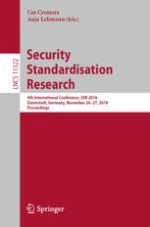2018 | Book
Security Standardisation Research
4th International Conference, SSR 2018, Darmstadt, Germany, November 26-27, 2018, Proceedings
Editors: Cas Cremers, Anja Lehmann
Publisher: Springer International Publishing
Book Series : Lecture Notes in Computer Science
